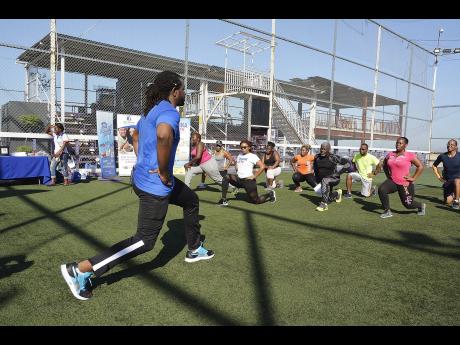Fit 4 Life | Back to basics for the ‘summa’
It's 'summa' and gyms, trails, and exercise classes are full to the brim. Everyone is looking for that new move or cutting edge tip that will give them the beach body look they desire. With the focus on show muscles – the ones we usually obsess about such as the abs or/and arms – holistic training is on the back burner.
Of course, Fit 4 Life has long preached against working out solely for looks – or likes – so ensure you cover the basics to keep you safe and improve your results.
These 'basics' are the fundamental movement patterns and you will want to master them if you are a beginner. However, even at higher fitness levels, training these patterns help to maintain balance and improve performance.
THE SQUAT
Squatting builds strength, endurance, and explosiveness in the lower body. Beginners should start with body weight squats and focus on form and control – weights should only be added after weeks of practice if you are new. Advanced athletes will find great benefit in single-leg variations.
Frequency: twice a week
THE LUNGE
The lunge is a bit more advanced than the squat but it is still one of the basics. Whereas squatting is in a fixed position, lunges build lower-body strength, endurance, explosiveness, and even flexibility through a stepping motion. Lunges require stability and strength to protect the knees and other joints, so it's OK to build these with exercises such as squats before attempting the lunge.
Frequency: twice a week
THE BEND
This is a hinge movement at the hips. One should be careful to avoid any rounding of the back in bending movements. The deadlift is perfect for training this movement pattern.
Frequency: once a week
THE PUSH
Push is an upper-body movement which targets muscles such as the chest, triceps and shoulders. The push-up, while challenging, is perfect for beginners who can manage to support their weight on the hands and knees or toes. Others might need to reduce body-weight or build upper body strength and endurance, using isolation moves before attempting this exercise.
Frequency: twice a week
THE PULL
Upper-body pull mostly relies on the muscles of the back, such as the rear delts and traps. The face pull is a smart choice for a pulling exercise. It can be done with light resistance bands in the comfort of your home and will go a far way in maintaining shoulder health and stability.
Frequency: twice a week
THE TWIST
Twisting is one of the easily overlooked movement patterns but will work wonders for core stability. The Russian twist will help build that stability.
Frequency: once a week
GAIT (WALKING, JOGGING, SPRINTING)
Gait refers to movements that combine the other basic patterns, for example, walking. These exercises torch calories, improve cardiovascular capacity and have a host of other benefits. For this task, high-intensity interval training is the go-to tool. Simply choose an exercise or three, perform it for a number of seconds, and then rest for a number of seconds. Our choice: a combination of jumping jacks, high-knees and mountain climbers performed one after the other followed by a rest period; repeat six times if you can.
Frequency: once a week
- Marvin Gordon is a fitness coach; email: marvin.gordon@physiqueandfunction.com; yourhealth@gleanerjm.com

